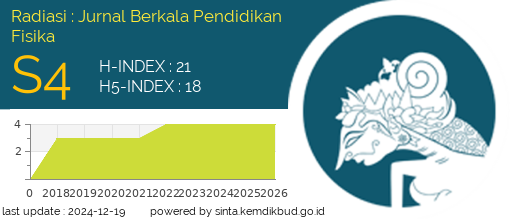The Effectiveness of Audio-Visual Based Learning Media Assisted by Adobe Software in Physics Learning
Abstract
As science and technology advance, reform efforts in the utilization of technological outcomes in the learning process become more common. The goal of this study was to determine the efficacy of developing Audio-Visual-based Physics learning medium for use in Physics classes. ADDIE is the method that was used (Analyze, Design, Development, Implementation, Evaluation). Analyze (analyze) the contents of determining the test subject, the program that will be used to create films, and the reference material that will be collected. The content is designed (development). Making films, adjusting the data collection instrument to the aspects to be examined Storyboard (story sequence + visuals) as a physics learning medium produced based on the results of earlier analysis, Implementation (implementation) displays the contents on the subject using the Zoom meeting application. Development (development) includes product realization and validation for material specialists and media experts. Observation (evaluation) Data is gathered using data collecting instruments such as a questionnaire sheet for one material expert and one media expert, as well as answer questionnaires for 15 early-level SWCU Physics and Physics Education students on nuclear material, with a 75 percent affirmative response rate hypothesis. Data analysis that has been descriptively, qualitatively, and quantitatively processed. The results of a questionnaire to material and media experts were 94.17 percent, and the results of the questionnaire responses found 93.68 percent of all aspects, with the majority of the subjects stating that the audio-visual-based physics learning media that was created was worthy of being used as learning media.
Downloads
References
K. Ratheeswari, “Information communication technology in education,” J. Appl. Adv. Res., vol. 3, no. 1, pp. 45–47, 2018.
C. Butcher, C. Davies, and M. Highton, Designing learning: from module outline to effective teaching. Routledge, 2019.
M. Hasan et al., “Media Pembelajaran,” 2021.
J. McDougall, M. Readman, and P. Wilkinson, “The uses of (digital) literacy,” Learn. Media Technol., vol. 43, no. 3, pp. 263–279, 2018.
M. Dhanil and F. Mufit, “Design and Validity of Interactive Multimedia Based on Cognitive Conflict on Static Fluid Using Adobe Animate CC 2019,” J. Penelit. Pengemb. Pendidik. Fis., vol. 7, no. 2, pp. 177–190, 2021.
F. Firdaus, “Efektivitas penggunaan media audio-visual dalam pembelajaran Sains,” SPEKTRA J. Kaji. Pendidik. Sains, vol. 2, no. 1, pp. 46–54, 2016.
N. L. Andriyani and N. W. Suniasih, “Development of learning videos based on problem-solving characteristics of animals and their habitats contain in IPA subjects on 6th-grade,” J. Educ. Technol., vol. 5, no. 1, pp. 37–47, 2021.
D. M. Anggraeni and F. B. Sole, “E-Learning Moodle, Media Pembelajaran Fisika Abad 21,” J. Penelit. Dan Pengkaj. Ilmu Pendidik. E-Saintika, vol. 1, no. 2, pp. 57–65, 2018.
C. Nicolaou, M. Matsiola, and G. Kalliris, “Technology-enhanced learning and teaching methodologies through audiovisual media,” Educ. Sci., vol. 9, no. 3, p. 196, 2019.
L. Mutia, G. Gimin, and M. Mahdum, “Development of blog-based audio visual learning media to improve student learning interests in money and banking topic,” J. Educ. Sci., vol. 4, no. 2, pp. 436–448, 2020.
M. Asriadi and E. Istiyono, “Exploration of Creative Thinking Skills of Students in Physics Learning,” J. Educ. Sci. Technol. EST, vol. 6, no. 2, pp. 151–158, 2020.
L. Bao and K. Koenig, “Physics education research for 21 st century learning,” Discip. Interdiscip. Sci. Educ. Res., vol. 1, no. 1, pp. 1–12, 2019.
S. Aini and F. Mufit, “Using Adobe Animate CC Software in Designing Interactive Multimedia Based on Cognitive Conflict in Straight Motion,” J. Penelit. Pendidik. IPA, vol. 8, no. 5, pp. 2350–2361, 2022.
F. P. Sari, S. H. Subroto, and F. Haroky, “Development of Audio-Visual Physics Animation Media to Improve Students’ Understanding of Concepts and Creativity,” J. Penelit. Pengemb. Pendidik. Fis., vol. 8, no. 1, pp. 125–134, 2022.
A. S. Darmawan and W. A. Setyani, “Development of Audio Visual Media for Distance Learning,” presented at the 6th International Seminar on Science Education (ISSE 2020), Atlantis Press, 2021, pp. 408–412.
W. B. Sulfemi, “Penggunaan Metode Demontrasi Dan Media Audio Visual Dalam Meningkatkan Hasil Belajar Peserta Didik Mata Pelajaran Ips,” Pendas Mahakam J. Pendidik. Dasar, vol. 3, no. 2, pp. 151–158, 2018.
Z. Abidin, “Penerapan pemilihan media pembelajaran,” Edcomtech J. Kaji. Teknol. Pendidik., vol. 1, no. 1, pp. 9–20, 2017.
F. R. Rahim, S. Y. Sari, P. D. Sundari, F. Aulia, and N. Fauza, “Interactive design of physics learning media: The role of teachers and students in a teaching innovation,” presented at the Journal of Physics: Conference Series, IOP Publishing, 2022, p. 012075.
Copyright (c) 2023 Elfira Josmin Filimditty, Alvama Pattiserlihun, Wahyu Hari Kristiyanto

This work is licensed under a Creative Commons Attribution-NonCommercial 4.0 International License.




